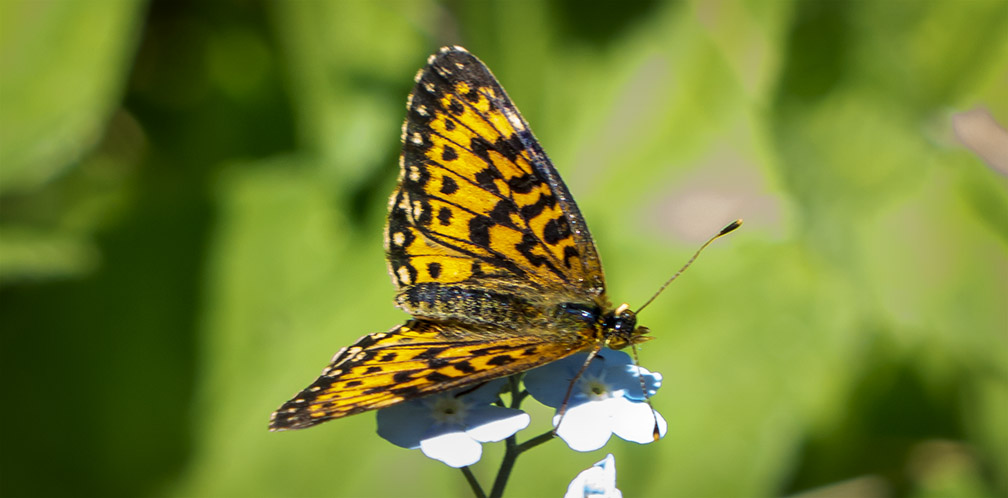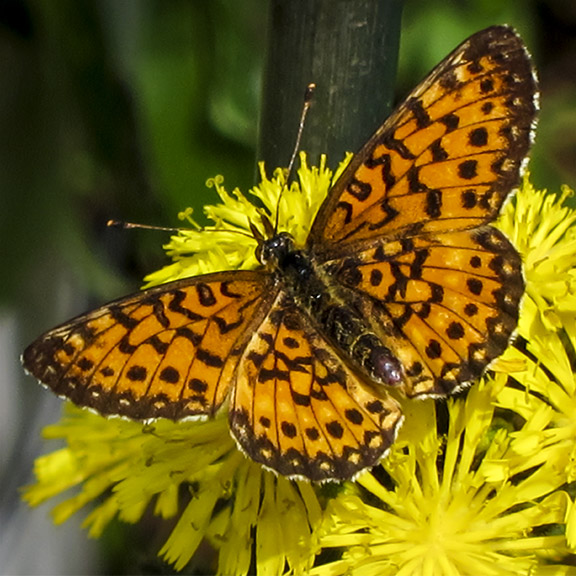Butterflies of the Adirondacks:
Silver-bordered Fritillary (Boloria selene)

The Silver-bordered Fritillary (Boloria selene) is an orange and black butterfly that may be seen in the Adirondack Mountains of upstate New York in summer. It is a member of the Brushfoot family. [1] This butterfly is one of the lesser fritillaries. [2] [3] It is noticeably smaller than the other fritillaries seen in the Adirondack region. [4] Some sources refer to it as the Silver Meadow Fritillary,[5] while others refer to it as the Small Pearl-bordered Fritillary. [6] This butterfly reportedly is named after Selene, a lunar deity in Greek mythology. [7]

From above, the Silver-Bordered Fritillary is orange with black markings. The black margins enclose pale orange spots. [8] [9] From below, this butterfly has a silver border along both outer wing margins. [10] It also has four rows of metallic silver spots. [11] The wing span of the Silver-bordered Fritillary is about 1.6 inches. [12]
The Silver-bordered Fritillary is similar in size and color pattern to the Meadow Fritillary, which is also found in the Adirondack Park. However, the Meadow Fritillary has less black on the lower hindwing from above. In addition, the Meadow Fritillary has a blunt and slanted forewing tip.
Male Silver-bordered Fritillaries patrol wet areas for females, [13] who lay their eggs singly near host plants. [14] Caterpillars feed on the leaves of violets. [15] [16] [17] Adult butterflies consume nectar from flowers such as goldenrod and Black-eyed Susans. [18]
The range of the Silver-bordered Fritillary extends from Alaska east to Newfoundland and south to Oregon, New Mexico, Illinois, and North Carolina. [19] Silver-bordered Fritillaries prefer wet areas, such as meadows and bog margins, often near wooded areas.[20] [21] It nectars in adjacent fields. [22]
This butterfly's flight period in the Adirondack Park has not been established. However, sightings in the region suggest that it is present in mid- and late-June and again in August.
- In 2012, the Silver-bordered Fritillary was present in the Paul Smiths VIC Native Species Butterfly House in June.[23]
- In 2013, Silver-bordered Fritillaries were present in the Butterfly House in mid- and late-June, and then again starting in early August until the Butterfly House closed in early September. [24]
- In 2014, there were confirmed sightings of this species in late June.[25]
References
- Susan Grimm Hanley. Interpretive Naturalist, Paul Smith's College Native Species Butterfly House. Species Logbooks.
- Butterflies and Moths of North American. Species Profiles. Sighting records: 6/16/2012; 6/15/2013; 8/5/2013; 8/10/2013; 6/22/2014; 6/22/2014; 6/22/2014.
- Government of Canada. Canadian Biodiversity Information Facility. SpeciesBank.
- Massachusetts Butterfly Club. Massachusetts Butterfly Species List.
- ENature. Field Guides.
- Iowa State University. Department of Entomology. BugGuide.
- Ross A. Layberry, Peter W. Hall, and J. Donald Lafontaine. The Butterflies of Canada (University of Toronto Press, 1998), pp. 176-177, Plate 14.
- National Audubon Society. Field Guide to Butterflies (New York: Alfred A. Knopf, 1981), pp. 550-560.
- Jim P. Brock and Kenn Kaufman. Kaufman Field Guide to Butterflies of North America (Houghton Mifflin, 2003), pp. 170-171.
- Paul A. Opler. A Field Guide to Eastern Butterflies (The Peterson Field Guide Series, Houghton Mifflin Company, 1992,1998), pp. 78-79, 243.
- Jeffrey Glassberg. Butterflies of North America (Michael Friedman Publishing, 2002), pp. 130-131.
- James A. Scott. The Butterflies of North America. A Natural History and Field Guide (Stanford University Press, 1986), pp. 318-319.
- Jeffrey Glassberg. Butterflies through Binoculars. The East. A Field Guide to the Butterflies of Eastern North America (Oxford University Press, 1999), p. 107-108, Plate 29.
- Paul A. Opler and George O. Krizek. Butterflies East of the Great Plains: An Illustrated Natural History (The Johns Hopkins University Press, 1984), pp. 137, Plate 23.
- Rick Cech and Guy Tudor. Butterflies of the East Coast. An Observer's Guide (Princeton University Press, 2005), p. 167.
- David Carter. Butterflies and Moths (Dorling Kindersley, Inc., 1992), p. 134.
- Thomas J. Allen, Jim P. Brock, and Jeffrey Glassberg. Caterpillars in the Field and Garden. A Field Guide to the Butterfly Caterpillars of North America (Oxford University Press, 2005), pp. 82-83.
